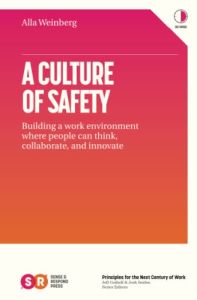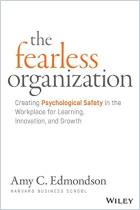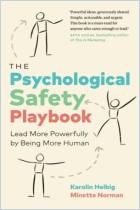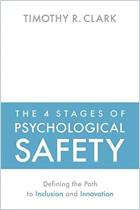Join getAbstract to access the summary!

Join getAbstract to access the summary!
Alla Weinberg
A Culture of Safety
Building a work environment where people can think, collaborate and innovate
Sense & Respond, 2020
What's inside?
A workplace where people feel physically, emotionally and psychologically safe lets creativity flourish.
Recommendation
Creating a safe environment for your employees increases their creativity and innovation. You will likely reduce “tragic failures” as well, says Alla Weinberg, CEO of Spoke & Wheel. After the 737 Max jet disasters, for example, Boeing found its employees had known about issues with the aircraft but hadn’t felt safe revealing them. Weinberg covers how to turn three types of safety – physical, emotional, psychological – into strong corporate values. She advises adding safety-building exercises – some of them clearly awkward but, she feels, worthwhile – to your meetings to help employees align with those values and to nurture stronger, more cohesive teams.
Take-Aways
- Companies that lack a culture of safety pay a steep price.
- Pay attention to the needs of the primitive brain.
- You may think your corporate culture reflects your values, but unless your values translate to defined behaviors, it probably doesn’t.
- Examine your response to fear: Are you a “persecutor, rescuer or victim"?
- Shift your management strategy from “fear-based” to “safety-based.”
- You can help your employees feel physically, emotionally and psychologically safer.
Summary
Companies that lack a culture of safety pay a steep price.
After two in-air disasters, Boeing grounded its 737 Max jets in order to investigate the cause of the accidents. The corporation’s culture turned out to be part of the problem. Employees kept silent about design issues because they feared for their jobs if they voiced their concerns. As part of addressing its problems, Boeing eventually fired its CEO.Creating an environment in which people can and will express themselves without fear of reprisal or criticism is a never-ending, ongoing process. When employees don’t feel safe or comfortable, teamwork and innovation suffer.
“When safety is compromised, people begin to protect themselves by holding back ideas, feelings and thoughts.”
Do employees ask questions and contribute in meetings? Do they take responsibility for their mistakes? Are team members willing to disagree or do they avoid conflict? Employees who feel safe know they can admit mistakes, work through conflicts and ask for help.Building a safe corporate environment begins with a company’s leadership. Think of a time and a group of people with whom you felt safe. Reflect on how that sense of security allowed the group to create solutions and deal with challenges. Identify what aspects of the group’s culture made you feel safe.
Select three to five people you work with who are important to your success. Write down what aspects of these relationships make you feel safe and what attributes you’d like the relationships to have. Compare that to the different shareholder groups in your orbit. Do you feel safer with your colleagues, staff or higher-up executives? Write down your answers and reflect on them.
Pay attention to the needs of the primitive brain.
Technology solves many business issues, but person-to-person cooperation still requires you to deal with human brains whose impulses have remained largely unchanged in the past 10,000 years. Animal predators may no longer threaten your life, but your primitive brain can interpret a critical email or a pending presentation as a threat.When your brain identifies a threat, cortisol and adrenaline flood your body. Your “mammalian brain” experiences your emotional response before your “rational brain” can take over. During this initial process, your primitive brain takes charge, reducing your “operating IQ” by 50%. Feeling threatened physically or emotionally at work impedes your cooperation, thoughtfulness and innovative thinking.
“Without a safe work environment, people literally cannot contribute what they know.”
You can’t control other people’s reactive brain, but you can build a work culture that doesn’t trigger defensive responses as frequently. Creating this environment requires assuring people of their physical, emotional and psychological safety – which corresponds to their primitive, mammalian and rational brains.
You may think your corporate culture reflects your values, but unless your values translate to defined behaviors, it probably doesn’t.
Author Brené Brown found that only 10% of companies have work cultures that align with their stated values. However, the leader of a group can dramatically change its relationship dynamics and reconnect it to its purpose and intent.
For example, US Navy Captain David Marquet spent a year studying the top-rated submarine and crew he thought he would be commanding, but his superiors reassigned him. His new vessel had the “lowest sailor reenlistment rate” in the service. Marquet did not choose his less-than-ideal circumstances, but he realized he could choose how he interacted with the crew.Since he’d spent a year focused on another vessel, Marquet acknowledged to his new crew that he didn’t know them and couldn’t yet “give good orders.” He opted to rely on the crew, stopped giving orders and trusted them to tell him when they needed to do something. If a sailor’s job required submerging the submarine, the sailor would inform the captain and then do it.This fundamental change altered how the crew interacted with Marquet and with one another. The submarine’s crew broke all naval performance records because the shipmates were empowered in their jobs and worked together as a cohesive whole.
“To shape the culture of your team…focus on…the relationships between individuals – starting with your relationships.”
To create the culture you want, don’t define it theoretically; instead, imagine your team or organizational culture as a “living, breathing” creature. How does it appear or move? Take this visualization further and ask your imagined creature-culture if it feels solid and secure. Ask what counsel it has for you. Use your senses to intuit what it is trying to tell you.
Examine your response to fear: Are you a “Persecutor, Rescuer or Victim"?
The Western notion of “stress” is a euphemism for feeling fear. To create a safe environment, leaders must strengthen their ability to experience fear and process fear’s related emotions.When you operate out of fear, you experience it as a tightening in your body, together with heightened emotions and a rush of self-critical thoughts. Any type of change can trigger these feelings. The more you can deactivate your nervous system and present calm energy to your people, the more they will be able to plug into their rational brains. Your goal isn’t to ignore fear, but to face it. The calmer you remain, the more able you will be to teach your colleagues and employees to relate to each other in new, safer ways.
The “Drama Triangle” features three points: Persecutor, Rescuer and Victim. These are also the three non-productive strategies people commonly use to handle fear: creating fights, undermining the sense of security and reducing intelligence. People may apply these behaviors to themselves or to others. Persecutors blame themselves or others for something that causes them fear. People use this strategy to avoiding feelings of discomfort.Rescuers try to avoid their feelings by helping others and staying busy. This causes a boom-and-bust cycle of productivity and exhaustion. They may also downplay other people’s fears by assuring them the situation will work out or by invalidating the feelings they express. Victims regard even global issues as personal. Once they feel they have lost their power, they may not stand up for their team members.
People shift through these roles until they escape the fear cycle. To lessen the hold these attitudes have over you, regularly practice the “fear inventory” exercise to calm yourself and build your ability to deal with fear. Set a timer for three minutes and imagine a situation you experienced that made you feel irate or disappointed. Using the prompt “I have a fear that I…,” write down your related fears. Don’t self-edit – let your thoughts flow. Read your “fear inventory” aloud, and then rip it up. This will decrease the hold your fears have on you.
Shift your management strategy from “fear-based” to “safety-based.”
Fear-based corporate management has existed since the Industrial Revolution. It uses “shame, blame, judgment and fear” to control employees.While people may comply with fear-based leadership, it makes them feel unsafe and stifles their ability to innovate and solve problems. “Safety-based” leadership is different. When a staff member makes an error, a safety-based leader thinks about the person’s feelings and acknowledges disappointment, but agrees with the employee that no one wanted a bad result. Leaders may ask why something went wrong, but they must harken back to the employee’s prior good decisions, and ask what steps could help rectify the problem. This creates a safe environment for discussion and taking responsibility.
“A shift from fear to safety is possible, and the fastest way to do that is to shift your beliefs.”
For example, the CEO of an equipment manufacturing company underwent the shift from fear-based to safety-based leadership while attending a wedding. He realized that employees are “entrusted” to a company as a husband and wife entrust themselves to one another. He came to understand that his employees aren’t cogs in a machine; they are human beings who deserve respect. His transformation led him to remove time clocks from the production line, provide additional personal development opportunities and openly recognize his staff members’ contributions. Shifting your beliefs requires you to act in new ways. If your usual stance is to believe you have to solve every problem yourself, consider, instead, that other people also can generate good ideas. Then ask, if you accepted this belief, how would you behave differently? Implement that change. The more you question your beliefs, the more quickly you can change your attitude to make those around you feel secure.
You can help your employees feel physically, emotionally and psychologically safer.
Cultivate a sense of physical safety: a shared belief that each person belongs to a group that appreciates and respects them. Once you achieve this, you can cultivate emotional and, then, psychological safety. To do so, help define your team members’ shared beliefs and support them with action. People have and express emotions. When we suppress our feelings at work, we decrease our ability to effectively collaborate with others.Emotional safety exercises validate other people’s emotions and let them express what they feel.To put them to use, integrate the following exercises at staff meetings – even if they generate discomfort at first:
- When you begin each meeting, use the group “Body Scan” exercise to create a calmer, more centered environment. Have the members sit comfortably. Ask people to close their eyes and concentrate on their breath. Read these instructions aloud, guiding them through the exercise. Ask them to mentally scan their bodies from head to toe, noticing anything that hurts or distracts them. When they finish, ask participants to notice their breathing again and open their eyes. Everyone should be more mindful and relaxed.
- Do the “The Three As” exercise monthly. Team members each receive one “appreciation” for something they did, one “acknowledgment” for who they are and an “apology” for something someone did to them, such as being late to a meeting they called, for example. One person can deliver all three elements, or different people can speak.
- At each meeting, check in with participants. Have each person describe his or her emotional state and where in their body they feel it. The leader can summarize the group’s feeling and change the agenda, if necessary. This exercise helps people understand what they feel and how that manifests physically.
- Meet with individuals or a team to hold “Venting Sessions.” These meetings allow people to express themselves and be heard. They will also reduce gossip in the group. Agree on a 5- to 20-minute limit for each person. Invite the individual to complain about something going on with the team. As each person talks, without interrupting, consider the issues that arise. When they finish, thank them.
When you start a project, have the team use a whiteboard to create two lists. One includes individual aspirations for the project. The other lists people’s worries. Everyone puts one item on each list. The group talks about the positive list first and then the concerns. If you see common elements, point them out. Have the team suggest how to achieve the positive goals and mitigate potential risks.
Hold a monthly “Mistake Celebration” to review lessons learned and to connect team members to one another. Make sure leaders go first in detailing what mistakes they made.
On a team, psychological safety reflects the belief that when you make a mistake, ask a question or suggest an idea, your team members won’t react negatively or reject you. Members of effective teams feel psychologically safe with each other. However, without that safety, people tend to remain silent in the face of problems with a project, the team or the boss. Cultivate this level of safety to avoid tragic failures, like those that occurred with Boeing’s planes.
“Psychological safety is about candor and a certain level of healthy conflict.”
Creating a feeling of psychological safety in a group is the opposite of merely “being nice.” It requires team members to confront each other and work through their issues.That means creating a safe culture can feel discomforting at first. To foster innovation, however, you must find ways to make sure that safety is not merely a voiced value. Make it a learned and practiced behavior.
About the Author
Spoke & Wheel CEO Alla Weinberg specializes in workplace relationships.
This document is restricted to personal use only.




















Comment on this summary